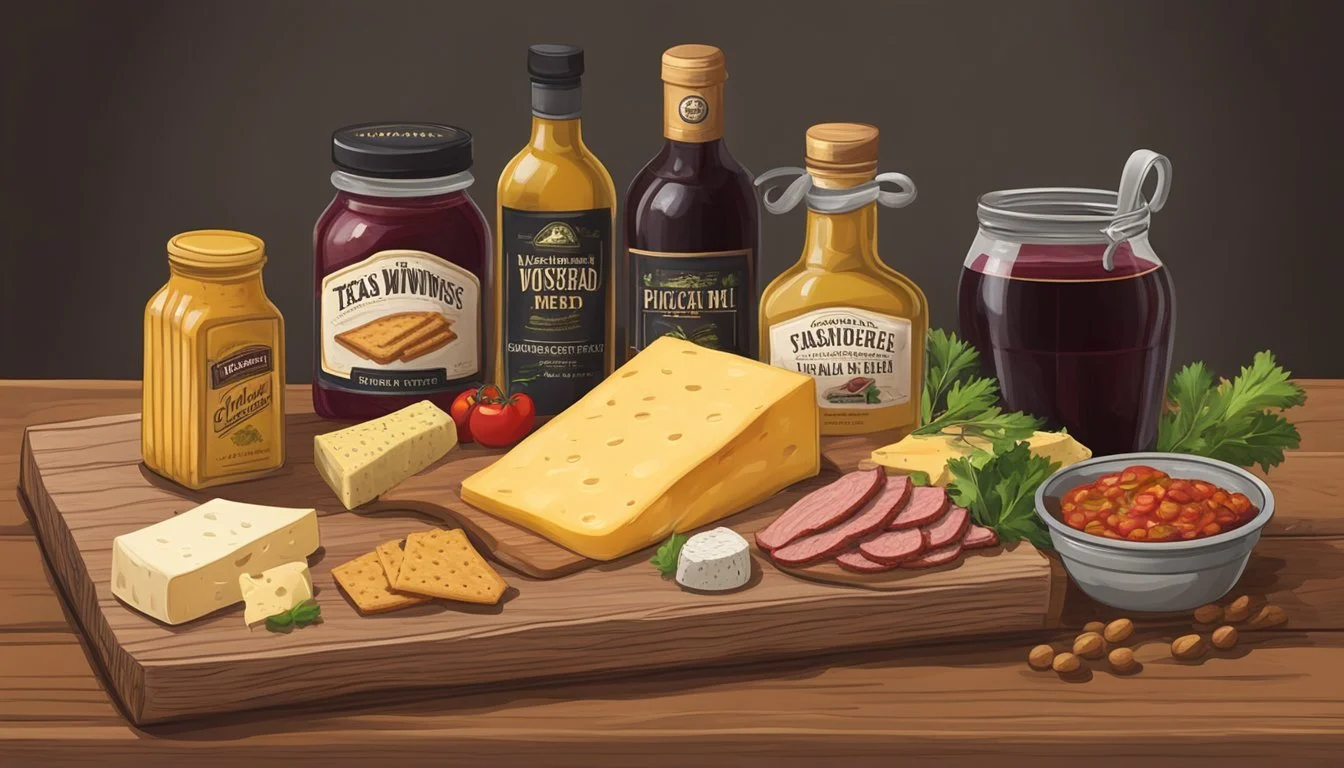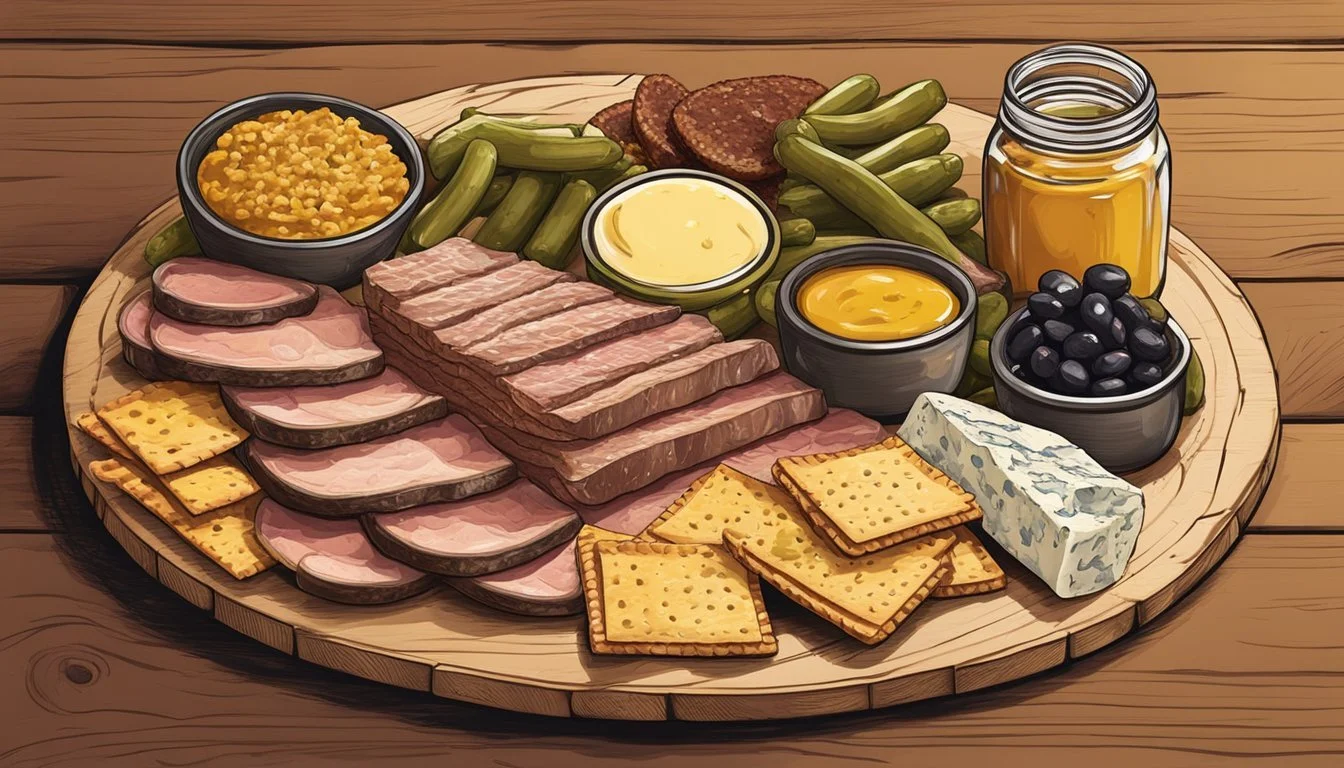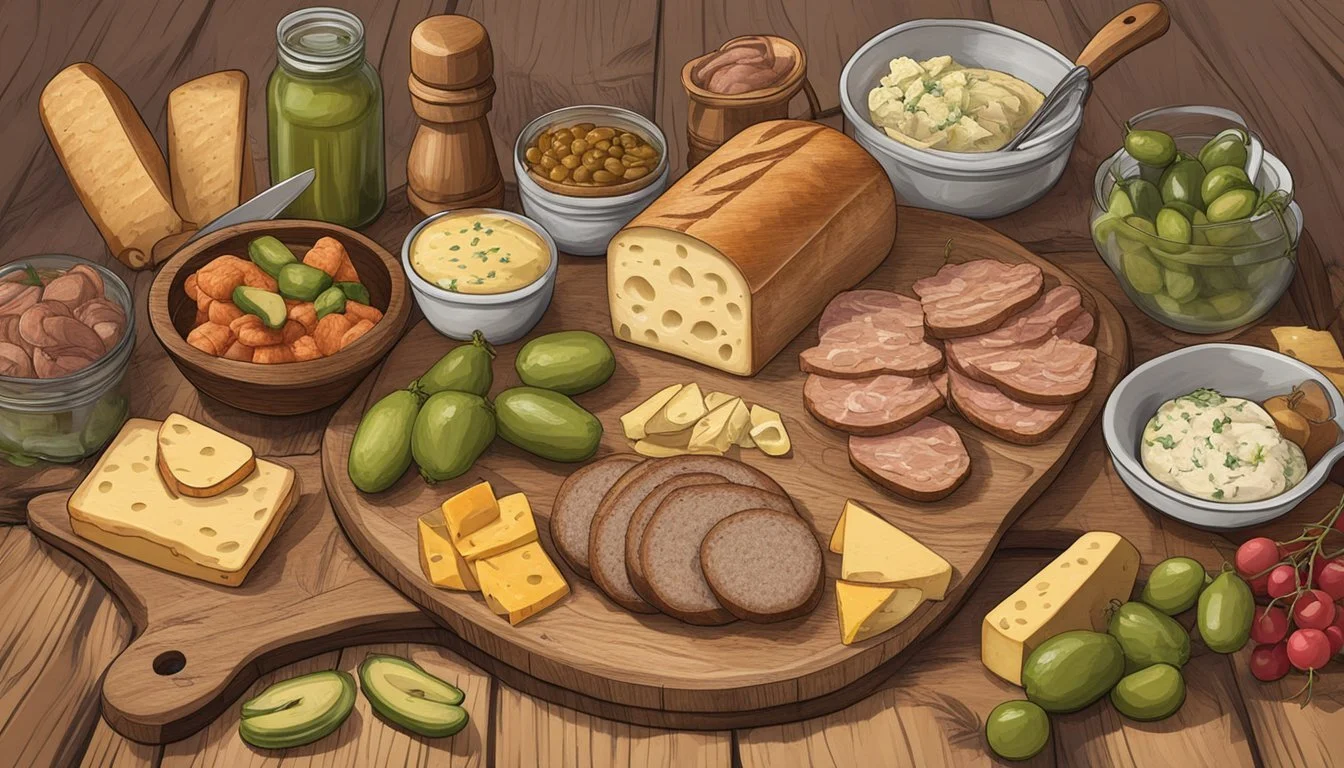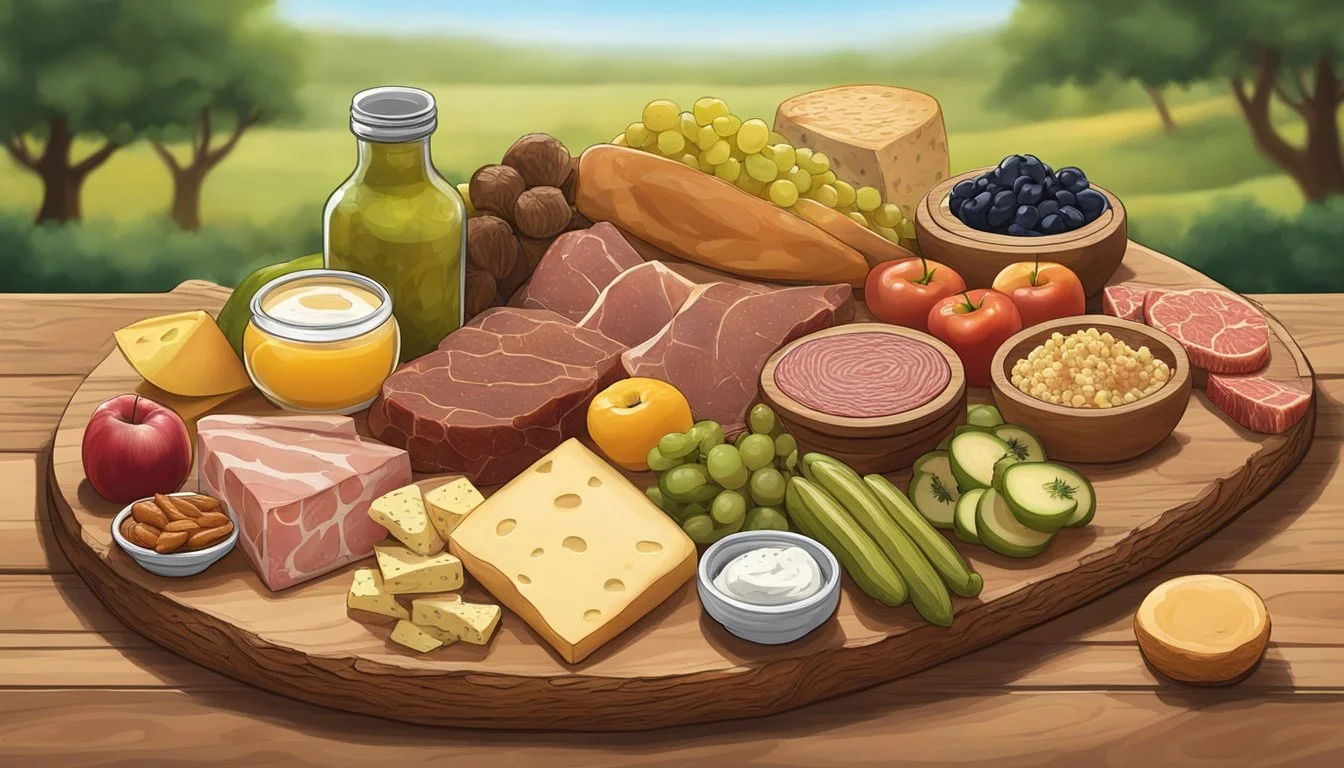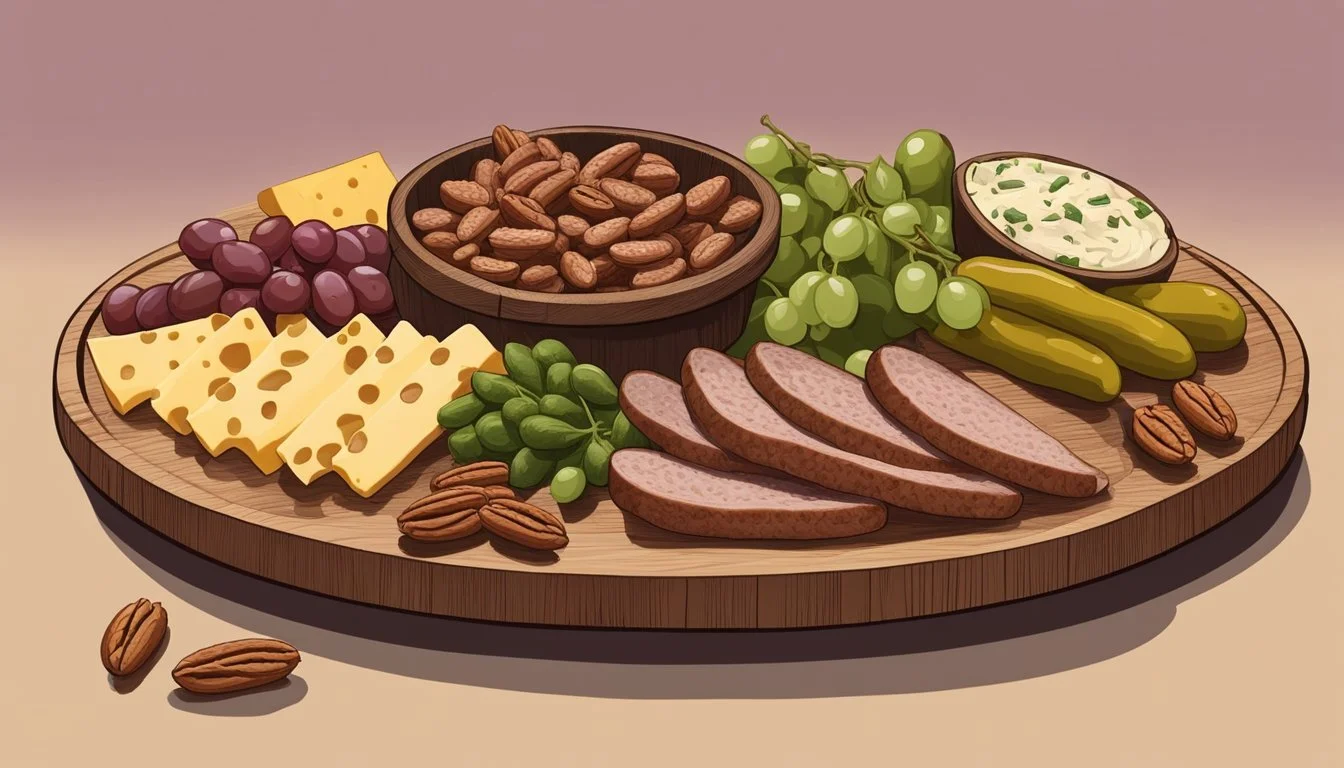How to Prepare a Texas-Style Charcuterie Platter
A Guide to Authentic Southern Flavors
A charcuterie (What wine goes well with charcuterie?) platter is a delightful way to begin any gathering, offering a variety of flavors and textures that guests can enjoy. When it comes to creating a Texas-style charcuterie board, the approach is all about embracing bold flavors and a hearty presentation that reflects the state's rich culinary heritage. The foundation of any good charcuterie board lies in its selection of meats, which typically include an assortment of cold cooked, cured, or smoked offerings.
In Texas, one might find the inclusion of locally sourced meats such as smoked brisket or venison (What wine goes well with venison?) sausage, adding a distinctive touch to the platter. Accompanying these are often robust cheeses (how long does cheese last?), an assortment of pickles, and perhaps some spiced jams or jellies that provide a sweet and spicy contrast to the savory bites. A Texas charcuterie board serves as a versatile appetizer, adaptable to the casual backyard barbecue or the more upscale social gathering.
Versatility is key; alongside traditional elements, a Texas-style platter might feature bold condiments like pickled okra or jalapeño jelly, and seasonal fruits for a fresh twist. The arrangement of these items is not only about aesthetic appeal but also about the practicality of serving, with each component thoughtfully placed for easy access and to encourage guests to create their own perfect bite.
Essential Components of a Texas-Style Charcuterie Board
Crafting a Texas-Style charcuterie board calls for a curated selection of bold meats, diverse cheeses, and an array of fruits and nuts that celebrate the richness of Texan flavors.
Choosing the Right Meats
The foundation of any charcuterie board is its meat selection. For a distinctive Texas twist, one should feature an assortment of robust meats such as smoked brisket or pecan-wood smoked ham, alongside traditional charcuterie selections including salami, prosciutto, and spicy sausages. These hearty flavors are a nod to Texas's barbecue heritage and its love for smoked and cured meats (What wine goes well with cured meats?).
Selecting Cheeses
The cheese assortment on a Texas-style board should include bold options that can stand up to the strong flavors of the meats. This might include:
Sharp cheddar, aged to perfection
Smoked gouda, infusing a hint of the grill
Jalapeño-studded Monterey Jack, for a spicy kick
These cheeses, along with perhaps a touch of blue cheese or soft brie, ensure a well-rounded flavor profile.
Incorporating Fresh and Dried Fruits
Fresh fruits like grapes and sliced pears offer a juicy counterbalance to the board’s savory selections. Scatter in some dried apricots and figs to introduce a concentrated sweetness that complements the saltiness of the meats and cheeses. These fruits also add a vibrant aesthetic appeal to the platter.
Adding Nuts and Other Crunchy Elements
To complete the board, one should scatter a variety of nuts such as pecans, almonds, and walnuts across the spread for a satisfying crunch. These nuts pair well with both the meats and cheeses, and their earthiness is evocative of the Texan countryside. Additional crunchy elements like pistachios or even smoked or spiced olives contribute to the array of textures and flavors that make a charcuterie board truly enticing.
Assembly and Presentation
When preparing a Texas-style charcuterie platter, the key is in its assembly and presentation. One must consider the interplay of flavors and the visual appeal, ensuring each element has its place to shine on the board.
Creating Patterns and Sections
The first step in assembly is to create distinct sections on the board. Patterns are not just aesthetically pleasing but also help guests navigate through the different options:
Meats: Space out various Texan meats like smoked brisket slices, spicy sausages, and cured ham in separate sections. One can roll, fold, or fan out the meats to add visual interest.
Cheeses: Choose robust Texan cheeses such as aged cheddar or pepper jack. Cut into cubes, slices, or wedges and place in groups around the board.
Crackers & Breads: Spread an assortment of crackers and sliced baguettes in accessible areas.
This orderly approach allows each food item its spot on the board, making for an enticing display and easy self-service.
Utilizing Garnishes and Herbs
Garnishes and herbs infuse the platter with freshness and can elevate the aesthetic:
Garnishes: Incorporate colorful elements like pickled okra, jalapeño slices, and cherry tomatoes. They provide pops of color and cleanse the palate between different meats and cheeses.
Herbs: Traditional Texas herbs like rosemary and thyme not only add subtle flavor but can also be arranged to create borders or dividers on the platter.
By thoughtfully placing garnishes and herbs, the charcuterie platter transforms into a dynamic landscape, offering both visual appeal and a zestful eating experience.
Complementary Items
When assembling a Texas-style charcuterie platter, the selection of complementary items is crucial. They enhance the flavors of the meats and cheeses and add textural contrast.
Breads and Crackers Choices
For a sturdy base, grain crackers and crispbreads offer a hearty texture that pairs well with robust Texas meats. Tortilla chips reflect the regional cuisine and add a familiar crunch. Arrange a mixture of these options to cater to different preferences and dietary needs.
Breads: A selection of local artisan breads, sliced for convenience.
Crackers: Grain crackers, buttery rounds, and crispbreads.
Tortilla Chips: Thick-cut and strong enough to support hearty dips.
Dips and Spreads Variety
Rich and creamy dips like aioli and olive oil-based tapenade serve as the perfect counterpoint to salty meats. Jam and mustard introduce sweet and tangy notes, respectively, creating a more complex tasting experience.
Mustard: A classic stone-ground or sweet honey mustard.
Aioli: A garlic-infused spread, ideal for pairing with bread and crispbreads.
Jams and Sauces: Fruit jams such as fig or apricot; spicy or smoky barbecue sauces.
Accompanying Pickled and Fresh Vegetables
Fresh and pickled vegetables add color, crunch, and a necessary acidity to cut through the richness of the platter.
Pickles: A variety of pickled cucumbers, okra, and jalapeños.
Pickled Vegetables: Offerings might include pickled carrots, onions, or beets.
Fresh Veggies: Sliced bell peppers, cucumbers, cherry tomatoes, and radishes for a refreshing bite.
Pairing and Flavor Balance
Creating an impeccable Texas-style charcuterie platter revolves around the harmonious pairing of flavors and textures. Ensuring each component complements the others, while also offering a variety of tastes and sensations, is crucial for a memorable tasting experience.
Matching Tastes and Textures
The art of charcuterie is in the careful selection and balance of tasty offerings that contrast and complement one another. Cheeses should range from soft and creamy to firm and aged, providing a plethora of textures for the palate. Meats bring both savory and spiced notes—thin slices of smoked brisket and peppery sausages are Texas must-haves. These should be juxtaposed with the crisp textures of pickled vegetables or the smoothness of pâtés and terrines.
Soft Cheeses: Pair with crisp textures like crackers or crusty bread.
Firm Cheeses: Serve alongside softer items such as prosciutto or salami.
Smoked Meats: Complement with tangy pickles or mustards.
Recommended Sweet and Savory Combinations
When constructing your platter, think of sweet and savory as dance partners in the flavorful ballet of a well-curated charcuterie board:
Fresh Fruit: Pairs beautifully with the saltiness of meats and the richness of cheeses. Examples include apples, pears, or figs.
Nuts: Almonds, pecans, or walnuts offer a crunchy respite that contrasts well with the tender textures of the meats and cheeses.
Dried Fruit: Dates or apricots provide a chewy sweetness which can balance out the savory bites.
Sweet Element Savory Pairing Grapes/Berries Sharp cheddar or gouda Honey Creamy brie or goat cheese Fig Jam Blue cheese or spicy chorizo
Incorporating these aspects into your Texas-style charcuterie platter will ensure a full suite of flavors and textures, satisfying a diverse array of palates.
Serving and Enjoyment Tips
A Texas-style charcuterie platter offers a fusion of bold flavors and textures. Practicing artistry in arrangement and mindfulness in serving sizes not only enhances the experience but addresses health considerations through nutrition information.
Arrangement Techniques
One should begin by selecting a large, flat serving board or platter as the foundation for the charcuterie arrangement. A variety of Texas-style meats including smoked brisket, spicy sausages, and cured ham should be the stars, complemented by regional cheeses like cheddar or Monterey Jack. The key to an impressive display is in the thoughtful placement of each item. Meats can be folded or rolled for visual impact, while cheeses should be sliced and assorted nuts and fruits scattered to fill gaps, adding both color and texture. Accompaniments like pickles and dips can be placed in small bowls around the board to break up the meat and cheese.
Meats: Folded, rolled, or fanned out for visual appeal.
Cheeses: Sliced and spaced evenly.
Nuts/Fruits: Scattered to add color and texture.
Pickles/Dips: In bowls to break up the display.
Serving Sizes and Nutrition
Charcuterie boards are meant for grazing, therefore portions should be considered to maintain balance in nutrition. Each serving from the platter should ideally consist of a small, sensible amount of each component — a few slices of meat, a piece of cheese, and a smattering of nuts and fruits. Nutrition information is essential for guests who may be tracking intake for dietary reasons or health concerns. Providing details on calories, sodium content, and fat can be helpful. It's important for them to know that while charcuterie offers protein and can be included in a balanced diet, they also tend to be high in sodium and saturated fats. Encouraging guests to assemble their plates with a variety of items ensures a well-rounded selection.
Portion size: A few slices of meat, one piece of cheese, a selection of nuts and fruits.
Nutrition information available for dietary and health considerations.
Balance: Variety in selection for a well-rounded diet.
Customization and Variations
A Texas-style charcuterie platter thrives on its versatility, where regional flair and dietary considerations take center stage. Incorporating seasonal fruits and optional ingredients allows for creative displays that reflect individual lifestyle attributes and Texas's bountiful produce.
Seasonal and Regional Twists
Texans pride themselves on local flavors, and their charcuterie is no exception. They often include seasonal fruits like peaches in summer or persimmons in fall to add a fresh, local element. The inclusion of Texas-crafted cheeses and local charcuterie meats, such as smoked brisket or venison sausages, can transport the palate straight to the Lone Star State. A visitor or resident can reflect their creativity by assembling ingredients that speak to Texas's rich culinary tapestry while highlighting the freshness of each season.
Vegetarian and Dietary Alternatives
With changing dietary needs, a Texas-style charcuterie platter can easily adapt to include vegetarian and other lifestyle-appropriate choices. For instance, smoked gouda or pepper jack cheese made from plant-based milks can substitute for traditional dairy. Alternative protein sources, such as marinated and grilled tempeh or seitan, (What wine goes well with seitan?) can be styled to mimic classic charcuterie meats. By showcasing a variety of vegetables, nuts, and fruits alongside gluten-free or low-carb crispbreads, hosts can ensure that their platter aligns with various dietary preferences while still embodying the spirit of Texas hospitality.
Health and Safety Considerations
When preparing a Texas-style charcuterie platter, it’s essential to consider the nutritional content of the ingredients and to follow safe food handling and temperature control protocols to ensure the health and safety of those partaking.
Understanding Nutritional Content
Ingredient Information: Each element of a charcuterie platter comes with its own set of nutritional information. For instance, cured meats are often high in sodium and saturated fats. On the other hand, cheeses can vary widely, with some offering high calcium content but also high fat.
Nutritional Guidance: Balance is key for health when consuming charcuterie boards. Including a variety of nutrient-dense food items like vegetables, fruits, and whole grains alongside meats and cheeses can enhance the overall nutritional value. It's advisable that consumers be mindful of portion sizes in relation to their overall dietary needs.
Proper Handling and Temperature Control
Safe Internal Temperature: Following USDA guidelines is crucial for meats that need cooking. Even on a charcuterie platter where meats are typically cured and served cold, ensuring they were brought to the right temperature during their initial preparation is important for food safety.
Cooking Times and Temperature Control:
Cured Meats: According to USDA guidelines, all cooked meats should reach an internal temperature high enough to eliminate any harmful bacteria before being consumed. Even though most meats on a charcuterie board are cured and pre-cooked, ensuring their proper handling before serving is integral.
Cheeses and Other Perishables: Items such as cheeses and spreads should be kept out of the danger zone, which is between 40°F (4°C) and 140°F (60°C), to prevent bacterial growth.
A simple rule is to not leave perishable items out at room temperature for more than two hours. If the ambient temperature is above 90°F (32°C), this time is reduced to one hour. Always store perishables in the refrigerator until it's time to serve to maintain freshness and safety.
Educational Insights
In crafting a Texas-style charcuterie platter, one's comprehension is enriched through an understanding of its historical significance and the importance of transparency in the ingredients used.
Historical Context and Evolution
Charcuterie, derived from the French 'chair' for flesh and 'cuit' for cooked, traditionally emphasized cured or smoked meats. Texas-style charcuterie platters have evolved to encompass a broader range of local flavors and ingredients, reflecting the state's cultural melting pot. Such platters often feature bold Texan meats like smoked brisket, along with an assortment of cheeses and accompaniments that pay homage to the state's history as a nexus for diverse food traditions ranging from Southern to Mexican cuisines.
Manufacturing and Ingredient Transparency
Ingredient Content:
Meats: Smoked brisket, jalapeño-cheddar sausage, and dry-cured ham.
Cheeses: Smoked Gouda, sharp cheddar, and queso fresco.
For educational purposes, it is pivotal to highlight the shifts in manufacturer product formulation changes. Manufacturers have become increasingly aware of consumer demands for natural ingredients and ethical sourcing. Ingredient lists have become more transparent, allowing consumers to understand the origins and processes behind the items on their charcuterie platter.
Ingredient Source Notes Meats Local farms Often highlighting natural processes and smokehouse traditions Cheeses Artisanal producers Focus on craftsmanship and quality over mass production Condiments Local markets Homemade or small-batch production preferred for authenticity
This transparency allows for an informed appreciation of the elements that make up a Texas-style charcuterie platter and encourages responsible consumer choices.
Expert Recommendations
Crafting a Texas-style charcuterie platter blends traditional preparation with local tastes. A focus on high-quality ingredients and skilled assembly ensures an authentic and delicious experience.
Selecting Quality Ingredients
Meats: A selection of Texas-style smoked brisket, peppered salami, and spicy chorizo forms the foundation. For best results, one should opt for freshly sliced meats that have been smoked or cured with Texan flavors.
Cheeses: Sharp cheddar, creamy Havarti, and smoked Gouda offer a variety of textures and tastes. Cheeses should be cut into manageable slices or chunks, making them easy to enjoy on the platter.
Fruits: Fresh fruits like figs, apples, and grapes provide a sweet balance to the savory meats and cheeses. Dried fruits such as apricots and dates offer concentrated flavors and a chewy texture.
Bread: Thick slices of rustic sourdough or traditional Texas toast give guests a sturdy base for building their bites. It's important to keep the bread simple to not overshine the meats and cheeses.
Products: Incorporate local Texas jams, such as peach or fig, and a spicy mustard or tapenade for layering flavors.
Professional Assembly Advice
Patterns: When assembling the platter, one should arrange the items in an appealing pattern that highlights the diversity of colors and shapes. Meats can be folded into halves or quarters or shaped into a rose for visual impact.
Garnish: Sprigs of rosemary or small clusters of grapes used as garnish not only add bursts of color but also infuse subtle aroma into the platter.
Creativity: Encouraging creativity in the arrangement, one can use small jars or bowls to add height and texture to the presentation. This also separates wet products like tapenades from the drier components like bread and sliced meats.
Platter: The platter itself is a canvas, so selecting a broad, flat surface with a Texas thematic—such as a wooden cutting board or a slate—can add authenticity to the presentation.
Conclusion
Creating a charcuterie board is both an art and a culinary exercise that allows for personal expression. A Texas-style charcuterie platter stands out for its bold flavors and unique combination of meats, often focusing on local BBQ staples. When one prepares a DIY charcuterie board, the goal is to balance taste and visual appeal, ensuring that each element complements the others.
Safety First: Always consult a healthcare provider for guidance on food safety and the proper handling of meats and cheeses to prevent any health risks.
Focus on Variety: A well-crafted board features a range of textures and flavors. Smoked meats, spicy sausages, and sharp cheddar cheese are staples of a Texan platter. They bring the rich and bold flavors that are signature to the region, offering guests an authentic taste experience.
Encourage Creativity: There's no single way to design a charcuterie board. Encourage guests to mix and match components to create their own flavor profiles. This interactive element turns the board from a mere meal into a central event, around which conversations and connections flow as freely as the flavors.
For Every Occasion: Whether it's an intimate family gathering or a large social event, charcuterie boards are versatile. They satisfy a wide range of dietary preferences, making them an inclusive option for any gathering.
In assembling a Texas-style charcuterie platter, one's personal touch is as important as the quality of the ingredients. Vigilant preparation and an understanding of how individual components come together ensure that the board will be a memorable part of any meal or event.



